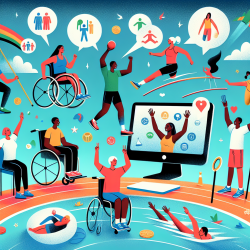Introduction
In recent years, the intersection of sports participation and sexual violence (SV) perpetration among adolescents has garnered significant attention. The research article "Sports Participation, Social Networks, and Sexual Violence Perpetration" provides valuable insights into how sports and social networks can influence behaviors and attitudes related to SV. This blog aims to explore the findings of this study and offer practitioners actionable strategies to improve outcomes for children and adolescents.
Understanding the Research
The study examined data from 20 high schools to investigate the relationship between sports participation, social networks, and SV perpetration. It focused on two types of SV: sexual harassment (SH) and forced sexual contact (FSC). The researchers explored whether athletes in certain sports were at higher risk of perpetrating SH and FSC compared to non-athletes and whether factors such as gender, dismissiveness of SV, and substance use intentions moderated this risk.
Key findings included a bivariate association between sport contact level and SH perpetration, which disappeared after adjusting for other covariates. Dismissiveness of SV, intentions to use substances, and prior perpetration emerged as the strongest predictors of SV perpetration. Additionally, the study highlighted the role of peers and trusted adults in influencing behaviors.
Implications for Practitioners
Practitioners can leverage these findings to enhance prevention efforts and create supportive environments for adolescents. Here are some strategies:
- Promote Positive Peer Relationships: Encourage diverse and inclusive social networks among adolescents. Facilitate activities that foster healthy peer interactions and discourage dismissive attitudes toward SV.
- Engage Trusted Adults: Strengthen the role of coaches, teachers, and other trusted adults in promoting prosocial behaviors and addressing dismissive attitudes. Training programs like Coaching Boys into Men can be effective in reducing SV perpetration.
- Address Substance Use: Integrate substance use prevention into SV prevention programs. Educate adolescents about the risks associated with substance use and its link to SV perpetration.
- Focus on Early Intervention: Implement prevention efforts before high school to address early signs of dismissive attitudes and risky behaviors. Tailor programs to the developmental needs of younger adolescents.
Encouraging Further Research
While this study provides valuable insights, further research is needed to explore the causal relationships between sports participation, social networks, and SV perpetration. Longitudinal studies can help clarify these associations and inform more targeted prevention strategies. Additionally, examining the role of non-school sports and trusted adults outside of school can provide a more comprehensive understanding of the factors influencing SV perpetration.
To read the original research paper, please follow this link: Sports Participation, Social Networks, and Sexual Violence Perpetration.










